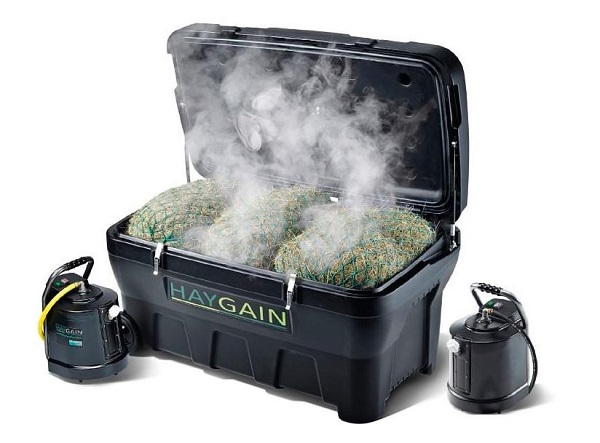Posted: 19th October 2018 | Back to news feed

Haygain, manufacturers of the eponymous, innovative hay steaming range (from £695.00), Forager slow feeders, Flexineb equine nebulisers and the Comfortstall flooring system, examine the pros and cons of soaking and steaming hay for insulin-resistant horses.
Horses can become insulin resistant for a range of reasons including obesity, metabolic syndrome, equine Cushing’s disease, and can be insulin sensitive due to polysaccharide storage myopathy (PSSM). Owners of insulin resistant horses face a tricky conundrum – they need to limit the levels of non-structural carbohydrates (NSCs) in their horse’s feed to lower the risk of complications such as laminitis but also know that horses have evolved as trickle-feeders. In an ideal world their horses would be able to browse for and consume lower-quality grass-based forage all day long without the risk of high sugar and carbohydrate levels. Good quality hay can present a problem for insulin-resistant or sensitive horses, and some owners turn to soaking to make it more suitable. Soaking removes water soluble carbohydrates (WSCs) and NCS from hay, and the longer it is soaked for the more of these nutrients you remove.

This all sounds ideal to allow an insulin-resistant horse to have free access to hay, however soaking hay has its considerable drawbacks. It leaches minerals and nutrients out the forage at the same time as the sugars and carbohydrates and lowers the levels of digestible fibre. Soaking hay raises the bacterial levels of the hay, dramatically decreasing the hygienic quality of the forage and the longer it is soaked for and stored after soaking, the higher the bacterial levels get. Soaking hay is hard work in a busy yard, making the forage extremely heavy to move around, prone to mildew and less palatable for the horses. Finally, soaking hay has a significant environmental impact. One bale of hay will require between 60 and 100 litres of water to effectively soak it, and this large volume water must be disposed of carefully afterwards as it is a recognised pollutant.
Haygain’s patented hay steamers were developed to lower the levels of respirable particles in hay, providing a safe, palatable forage that helps to prevent respiratory disease in horses. The company and its products now have an international following of vets, riders and trainers who wouldn’t use anything else for their own horses. Recent research has looked at the effects of steaming on NSCs in hay, to see if this could take the place of soaking hay to be fed to insulin resistant horses.
In order to be safely ‘free-fed’ to insulin resistant horses, hay should have an NSC level of less than 10%. The results of this study showed that while soaking still remains the most effective method for lowering the levels of NSCs in hay, steaming it also had a noticeable impact. Soaked hay reduced the levels of NSCs versus those seen in the dry hay by 16.8%, and steaming reduced them by 7.2%. The hay in the study had a very high level of NSCs to begin with (20.8%), so in this case none of the hay, soaked, steamed or dry, would have been suitable for an insulin-resistant horse. A different study looked at the hay ‘as-sampled’ instead of dry, which considers the moisture levels of the hay when it is being used in a realistic stable environment. In this study, the NSC levels in steamed hay were within the limits acceptable to be free-fed to insulin resistant horses. Both studies showed that the steamed hay retained important minerals, bar iron which actually contributes to insulin resistance. Steaming also mitigates the other negative outcomes from soaking such as increased in bacteria levels and decreased palatability.
The outcomes of this research suggests the traditionally perceived go-to solution of soaking hay for the insulin resistant horse is not always enough and has several draw backs. Horse owners looking for an easy way to lower NSC levels in hay for their insulin resistant horse but leave it palatable and safe could look no further than the Haygain hay steamers. A suitable source of hay should be selected and tested so it is known by how much the NSC levels need to be reduced by. If levels are high and need significantly reducing in order to come under the recommended less than 10% then researchers Moore-Colyer MJS, Lumbis K, Longland AC, Harris PA. (2014) recommend to soak first and then steam and found this was the most effective method to produce a low-calorie hay which is also clean and safe to feed.
The Haygain range comprises hay steamers in sizes perfect for the leisure rider with one horse all the way up to the busiest competition yards. Take a look at the website here: https://haygain.co.uk/collections/equine-hay-steamers
The Equestrian Index newsfeed is compiled from articles submitted by advertising members and expresses the opinions of those members. Watsons Directories Ltd shall not be held liable for any inaccuracies or mis-statements therein.